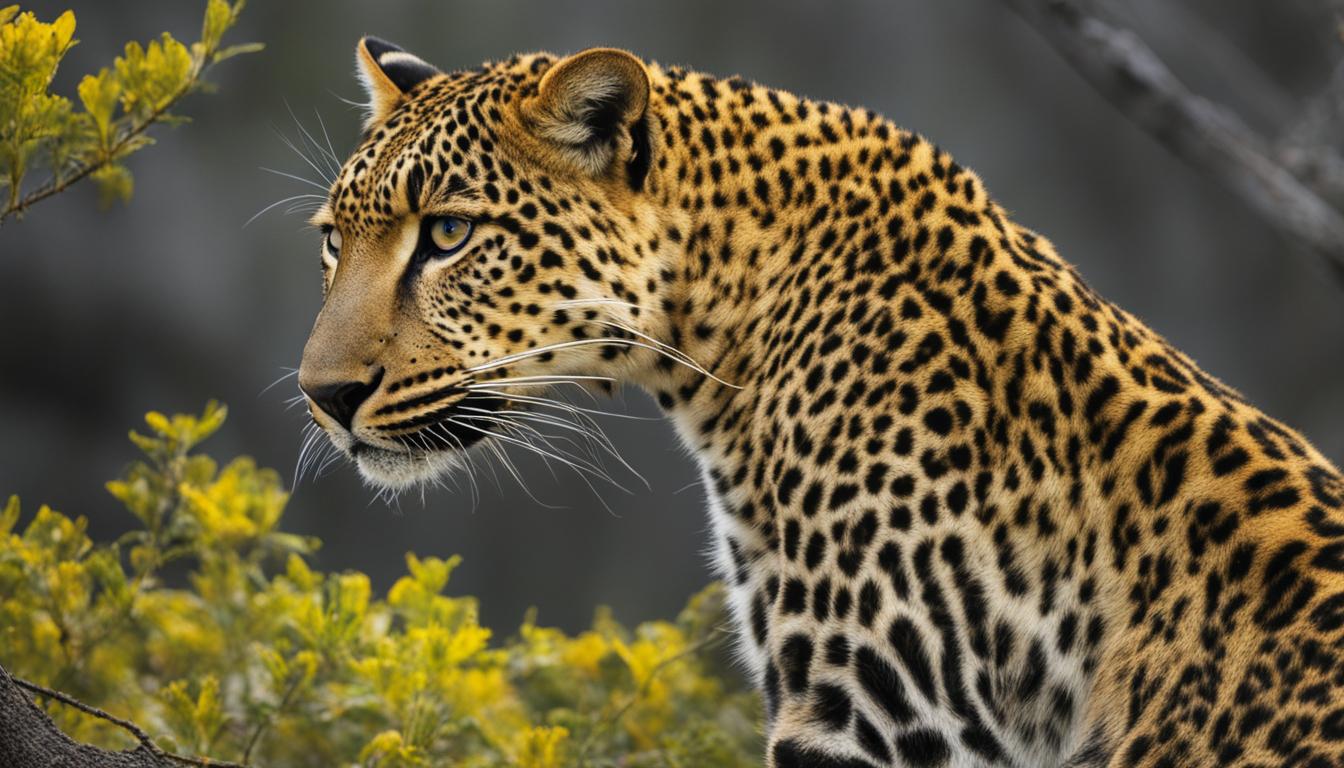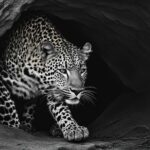Welcome to our article on the average lifespan of leopards in the wild. If you’ve ever wondered about how long these majestic creatures live, you’ve come to the right place. Leopards, belonging to the Panthera genus, are fascinating big cats with unique characteristics.
Leopards are known for their beautiful coats, which can range from tawny to reddish-orange, adorned with dark rosettes. These agile climbers, fast runners, and strong swimmers are the smallest of the large cat species, weighing between 46 to 165 pounds.
In their natural habitats, leopards have an average lifespan of 12 to 15 years, showcasing the aging process these magnificent creatures go through. However, in captivity, leopards can live up to 23 years, benefitting from consistent feeding and controlled environments. Let’s explore further factors affecting leopard lifespan and their fascinating social structure.
Factors Affecting Leopard Lifespan
Leopards, like many other wildlife species, face numerous challenges that can impact their lifespan in the wild. These factors include habitat loss and fragmentation, poaching, predation, and the coexistence with other apex predators. Understanding these influences is crucial for implementing effective conservation strategies to ensure the survival of leopard populations.
Habitat Loss and Fragmentation
Habitat loss due to urban expansion and deforestation has a significant impact on leopard populations. As their natural habitats shrink, leopards face a decrease in available food sources and suitable hunting grounds. This can lead to malnutrition and an increased risk of conflict with humans as they venture into human settlements in search of food.
Additionally, habitat fragmentation further exacerbates the challenges faced by leopards. Fragmented habitats restrict their movement and can result in isolation of populations, reducing genetic diversity and increasing the risk of inbreeding. Ultimately, this negatively affects the long-term survival and resilience of leopard populations.
Poaching and Predation
Poaching for fur and body parts remains a significant threat to leopards, driven by the demand for their beautiful coats. Despite international efforts and regulations, illegal hunting continues to pose a serious risk to leopard populations, notably in regions where enforcement is weak.
Leopards also face predation from other apex predators such as lions, tigers, and hyenas. These larger carnivores compete for resources and may even kill leopard cubs, further impacting their survival rate. The presence of such predators in their habitats necessitates a delicate balance and can influence the lifespan of leopards.
Human-Leopard Conflict
Human activity, including retaliatory killings by farmers to protect their livestock, poses a significant threat to leopards. As human settlements expand into leopard habitats, conflicts arise when leopards prey on domestic animals. This often leads to retaliatory killings, further endangering leopard populations. Implementing measures to mitigate human-leopard conflicts and promoting coexistence is essential for the long-term survival of these magnificent predators.
| Factors Affecting Leopard Lifespan | Description |
|---|---|
| Habitat Loss and Fragmentation | Urban expansion and deforestation lead to shrinking habitats, decreased food sources, and restricted movement of leopards. |
| Poaching and Predation | Illegal hunting for fur and body parts, as well as predation by other apex predators, poses a serious threat to leopard populations. |
| Human-Leopard Conflict | Retaliatory killings by farmers and conflicts arising from leopard predation on domestic animals contribute to the decline of leopard populations. |
Reproduction and Social Structure of Leopards
The reproduction and social structure of leopards play a crucial role in their survival and population dynamics. Understanding how these majestic creatures breed and interact with one another provides valuable insights into their behavior and the conservation efforts required to protect them.
During the breeding season, male and female leopards utilize scents to locate each other. The gestation period lasts approximately three months, after which the female gives birth to a litter of two to three cubs on average. These cubs are born blind and vulnerable, and the mother remains by their side for the first few days, ensuring their safety before embarking on hunting expeditions.
In their early stages, female leopards move their cubs from den to den while hunting, ensuring their protection from potential predators. As time progresses, the cubs grow stronger and are eventually able to accompany their mother on hunting trips. This process aids in their development and prepares them for the solitary life that awaits them as adults.
Leopards are highly territorial animals, marking their domain with urine and claw marks on trees. They are predominantly solitary creatures, with minimal interaction between individuals, except during the mating season or when raising their young. This solitary nature allows them to avoid unnecessary conflicts and ensures the preservation of their resources within their territories.
Table: Social Structure Comparison of Leopards and Other Big Cats
| Species | Social Structure |
|---|---|
| Lion | Prides consisting of multiple males, females, and their offspring |
| Tiger | Solitary, although males may briefly interact with females during mating |
| Jaguar | Mostly solitary, with some marginal overlap of territories between males and females |
| Cheetah | Males may form small groups called coalitions, females are solitary |
| Leopard | Predominantly solitary, minimal interaction between individuals |
By understanding the unique dynamics of leopard reproduction and their solitary social structure, conservationists can develop strategies to protect these magnificent creatures and ensure their long-term survival.
Leopard Populations and Conservation Efforts
Leopard populations around the world face numerous threats and challenges that put their survival at risk. Habitat loss and fragmentation, primarily due to urbanization, have resulted in a decrease in the availability of suitable habitats and prey for leopards. This, in turn, has led to conflicts with humans as leopards venture into human settlements in search of food. Poaching for fur and hunting by farmers to protect their livestock further exacerbate the threats faced by leopards in the wild.
The dynamics of leopard populations vary across their range. In some areas, populations are stable or even increasing, while in others, they are declining rapidly. For instance, the Amur Leopard, found in eastern Russia, is one of the rarest subspecies with an estimated population of only 30 individuals in the wild. This critically endangered population requires urgent conservation efforts to prevent its extinction.
Conservation organizations, local wildlife parks, and governments are actively involved in efforts to protect and conserve leopard populations. Research and monitoring programs are implemented to gather data on leopard populations and assess population trends. Technology, such as trail cameras, is used to identify individual leopards and gather valuable information on their behavior and distribution.
Furthermore, legal frameworks and international agreements, such as the U.S. Endangered Species Act, aim to protect leopards and their habitats. These regulations restrict hunting, trade, and poaching of leopards, thereby providing them with legal protection. By implementing effective conservation strategies and raising awareness about the importance of protecting leopards, we can work towards ensuring the long-term survival of this magnificent species.
Below is a table summarizing the key factors affecting leopard populations and the conservation efforts being undertaken:
| Threats | Conservation Efforts |
|---|---|
| Habitat loss and fragmentation | Conservation organizations work towards preserving and restoring leopard habitats. Protected areas and wildlife corridors are established to ensure suitable living spaces for leopards. |
| Poaching and hunting | Strict laws and regulations are enforced to combat poaching and hunting. Anti-poaching patrols and law enforcement efforts are strengthened to deter illegal activities. |
| Conflict with humans | Education and awareness programs are conducted to promote coexistence between leopards and local communities. Livestock compensation schemes and predator-proof fencing are implemented to reduce conflicts. |
| Research and monitoring | Scientific research and monitoring programs help gather data on leopard populations, behavior, and habitat requirements. This knowledge informs conservation strategies and management plans. |
The collective efforts of scientists, conservationists, governments, and local communities are essential for safeguarding leopard populations and ensuring their long-term survival. By addressing the threats they face and implementing effective conservation measures, we can create a future where these magnificent big cats continue to roam the wild.

Leopard Lifespan in Captivity
Leopards, when held in captivity, have a considerably longer lifespan compared to their wild counterparts. In controlled settings such as zoos, leopards have been known to live between 21 and 23 years. This extended lifespan can be attributed to several factors that contribute to their well-being and longevity.
Firstly, in captivity, leopards receive consistent feeding, ensuring they have access to a balanced diet throughout their lives. This consistent nutrition helps support their overall health and increases their chances of living longer. Additionally, captive leopards are protected from food scarcity, a common challenge faced by leopards in the wild.
Another factor contributing to the increased lifespan of captive leopards is the limited exposure to environmental changes and potential dangers. In their natural habitat, leopards must constantly adapt to changes in their surroundings, which can be stressful and even life-threatening. In captivity, however, these environmental stressors are minimized, allowing the leopards to live a relatively stable and stress-free life.
Lastly, captive leopards are also less prone to diseases commonly found in the wild. In their natural habitat, leopards can contract various infectious diseases, some of which can be fatal. In captivity, they are regularly monitored and provided with necessary medical care, reducing the risk of illness and increasing their chances of survival.
While captivity offers certain advantages in terms of leopard lifespan, it is worth noting that the behavior and natural instincts of leopards may be altered in such settings. They may not exhibit the same behaviors and characteristics as those observed in the wild. Additionally, the exact average lifespan of leopards in the wild is challenging to determine due to their elusive nature and difficulty in tracking them accurately.
Understanding the factors that influence leopard lifespan in captivity provides valuable insights for the conservation and management of these magnificent animals. By implementing effective strategies to ensure their well-being and continued survival, we can contribute to the preservation of leopard populations for future generations to appreciate and admire.
Conclusion
Leopards have a fascinating lifespan, with wild leopards typically living for 12 to 15 years on average. However, in captivity, they can thrive and live up to 23 years. These majestic creatures face numerous challenges that affect their survival, including habitat loss, poaching, predation, and the impact of human activities.
Conservation efforts have become critical in protecting leopard populations, particularly those that are endangered or threatened. Various organizations, wildlife parks, and conservation laws are working tirelessly to monitor and survey leopard populations, implement protective measures, and raise awareness about their plight.
Understanding the lifespan of leopards and their population dynamics is essential for effective conservation strategies. By studying and monitoring these magnificent creatures, we can make informed decisions to safeguard their future. Through sustained efforts, we can ensure that leopards continue to thrive in the wild, and their beauty and presence are preserved for generations to come.
Is the Lifespan of a Cheetah Similar to That of a Leopard in the Wild?
The average cheetah lifespan in the wild is around 10 to 12 years, while the lifespan of a leopard in the wild is similar, ranging from 12 to 17 years. Both big cats face threats such as human-wildlife conflict and habitat loss, impacting their lifespan in the wild.
FAQ
What is the average lifespan of a leopard in the wild?
The average lifespan of a leopard in the wild is 12 to 15 years, although some can live up to 23 years in captivity.
What factors can affect the lifespan of a leopard?
Several factors can influence the lifespan of a leopard, including habitat loss, poaching, predation, and human activity.
How do leopards reproduce and what is their social structure?
During the breeding season, male and female leopards use scents to find each other. The female gives birth to a litter of 2 to 3 cubs on average, and she stays with them until they are old enough to venture out with her. Leopards are mostly solitary animals and mark their territory with urine and claw marks on trees.
What is being done to protect leopard populations?
Conservation efforts are being made to protect leopard populations, especially those that are endangered or threatened. This includes monitoring and surveying leopard populations, using trail cameras to identify individual leopards, and implementing laws to protect these endangered species.
How long do leopards live in captivity?
In controlled settings such as zoos, leopards can live between 21 and 23 years, which is longer than their lifespan in the wild.
What is the overall conclusion about leopard lifespan?
Leopards have an average lifespan of 12 to 15 years in the wild, but various factors can influence their survival. Conservation efforts are important for protecting leopard populations and studying and monitoring them is crucial for implementing effective conservation strategies.







